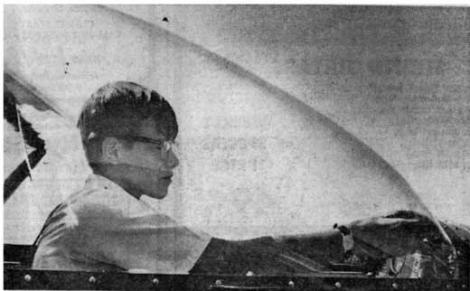
Public Site
| Members only: Restricted Docs Membership Biographies Your Account Your Flights Mailing Lists Badges Board Notes CrossCountry Instructors Logsheets Students Tracking Admin |

|

|
|
by FIFI GORSKA You can't drive a car until you're 16, but at 14 you can get up in the sky and glide like a big bird. Officially, it's a sport called soaring. Unofficially it's called "feeling you're free, not depending on anything." That's the description Steve Galinaitis of Herndon High gives when you're thousands of feet above the ground in a motorless craft. You're at the control stick feeling out the winds that will push you and |
your sailplane higher in the air. "The only sound you hear is the wind on the wings," says Steve. "It sort of rumbles. And when you push the stick forward and you dive, it whistles." Steve is one of about 35 teen-agers from the washington area who soar at Godfrey Field in Leesburg on weekends, Wednesdays or holidays at the Capital Area Soaring School, Inc. Anybody can go there with about $10 and soar, like buying a ticket on a ride at an |
amusement park, but these teen-agers, who make up 20 percent of the 12 to 60ish types who soar seriously, are making their off-time major. They are after their glider Continued on page 10 A bright sun makes the sky look dark by contrast as a soaring motorless craft reflects its rays over Godfrey Field in Leesburg, Va. |
|
continued from page 7 pilot certificates that means they can solo in a sailplane over the countryside without an instructor behind them. They mow lawns, wash cars, do any kind of odd jobs available to get the money to go to the soaring school that Mr. and Mrs. Gordon Bogora and Mr. and Mrs. Lewis Tuttle operate. Teen-agers make good soarers because they catch on fast to instruction, especially meterology, says Mrs. Bogora. The teens also catch on fast to what it means to go flying around in the clouds. Mike Pohlig of Falls Church High says he's gone 90 in a car, but it doesn't compare to the thrill of going 40 in a glider. "It's much more fun than driving. You watch out for birds as you hunt and probe for a thermal (hot air) that will push you up and give you a longer ride." There's no motor to make a noise, just the air whispering and rushing by, like wind in the trees." The teen-agers are careful to stay within a 3 to 5-mile radius of Godfrey Field because if they land in someone's cornfield they have to pay a 50-cent a mile to be carted back. Mike who is 14, began soaring in June and soloed in July after 23 lessons. At 16 he can try for his license that will enable him to take up a passenger. Some of the boys have gone |
on from soaring to trying for real pilot's licenses in motored planes. Others have been "grounded" temporarily due to college enrollments. Take Eric Moe, a Churchill grad who is a student at Gettysburg College. Eric saved his money to take soaring lessons all last summer. The time came when he thought he should inform his parents that "he had done something he was proud of but please don't be angry." He shifted from foot to foot, his mother recalls, as he announced he had soloed in a sailplane. "His father thinks flying is for the birds," Says Mrs. Moe, "but he grinned (undoubtedly happy with the thought that Eric's sophomore year at college would take him out of the sky for a while.)" The teens who like soaring, don't give up easily, however, even when they have to wait hours and hours for the tow plane to come by and the others in line ahead of them take off in the sailplanes. "We just sit under a tent at the field and listen to more experienced glider pilots tell stories," says Steve Then it's Steve's turn, and he becomes a surfer of the air waves, a sailor of the sky, a rider in the sky and any other term you can give to feeling like a bird. They have found freedom. They can taste it. |

|
|
The glider's canopy is locked and Mike prepares for a tow plane
to pull him up into the sky where he'll soar at 3,000 feet. |
|
Original Article (184924 bytes) |
|||||
| Return to Chapter II | |||||
| Foreword, Acknowledgements, Introduction & Overview | Chapter I The Beginnings |
Chapter II Capitol Area Soaring School |
Chapter III Warrenton Soaring Center |
Chapter IV Skyline Soaring Club, New Market |
Chapter V Skyline Soaring Club, Front Royal |